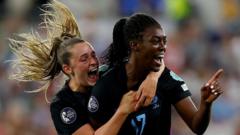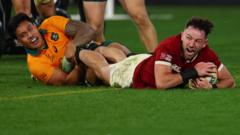Why Discuss Periods, Breasts, and Injuries in Women's Sports?

The Scientific Revolution in Women's Sport: Understanding the Female Body
As the Euros wrap up, a significant evolution is occurring off the pitch, amidst the thrill and drama of women's sports. Scientific research is taking center stage to explore how elite sports influence the female body. This includes examining the effects of breast movement on running efficiency, the menstrual cycle's impact on performance, and understanding the increased risk of specific injuries in female athletes. This exploration is a far cry from the past, when female athletes were often dismissed as "mini-men." The focus today is on recognizing and addressing the unique physiological and psychological challenges women face in sports.
The Impact of Breast Movement on Athletic Performance
One of the most fascinating areas of research is how breast movement affects athletic performance. Prof. Joanna Wakefield-Scurr, known as the "Bra Professor" from the University of Portsmouth, has been a pioneer in this field. Her studies demonstrate that the mass of breast tissue can significantly alter a woman's biomechanics during physical activity. For instance, heavy breasts can cause changes in torso movement and affect how force is exerted on the ground. This alteration can lead to shorter stride lengths, which can accumulate over long distances, such as in marathons.
Wakefield-Scurr's research indicates that inadequate breast support can reduce a runner's stride length by up to four centimeters. When considering the length of a marathon, that loss can add up to a mile of extra running distance. More than just a comfort issue, sports bras are now recognized as essential performance gear that protects the breast's delicate structures and prevents long-term damage.
The Menstrual Cycle and Its Effects on Performance
The menstrual cycle also plays a crucial role in athletic performance, influencing emotions, sleep patterns, and energy levels. Calli Hauger-Thackery, an Olympic distance runner, shares her experiences of how her body feels in the lead-up to her period. She describes symptoms like fatigue and heavy legs, which can make training feel more challenging. For many female athletes, tracking their menstrual cycle is vital, as the timing of their period can cause anxiety, especially before significant competitions.
Prof. Kirsty Elliott-Sale, a specialist in female endocrinology, explains that while hormonal fluctuations influence physical and emotional states, there's no clear-cut phase where women are definitively weaker or stronger. Historical evidence exists of women achieving remarkable feats during their periods, including Paula Radcliffe, who broke the marathon world record while suffering from cramps. This highlights the complexity of the relationship between the menstrual cycle and athletic performance, suggesting that personal experiences vary widely among athletes.
Addressing the Taboo: Open Discussions on Menstruation in Sports
Organizations like Sale Sharks Women are leading the way in breaking the taboo surrounding menstruation in sports. Former England rugby captain Katy Daley-McLean emphasizes the importance of discussing periods openly to better prepare for competitions. By sharing knowledge and strategies, athletes can learn how to manage the symptoms of menstruation, such as taking pain relief proactively during their cycle. This proactive approach not only improves performance but also fosters a supportive environment for athletes to thrive.
The Increased Risk of Injuries in Female Athletes
One of the pressing issues facing female athletes is the higher susceptibility to specific injuries, particularly anterior cruciate ligament (ACL) injuries. According to Dr. Thomas Dos'Santos, a sports biomechanics researcher, women are three to eight times more likely to suffer ACL injuries than men, depending on the sport. This increased risk is not solely attributed to anatomical differences; hormonal fluctuations throughout the menstrual cycle may also play a role in ligament strength and elasticity.
Dr. Dos'Santos points out that while anatomy is a factor, the lack of quality support and strength training for female athletes contributes to the higher injury rates. He advocates for training techniques that focus on improving movement patterns to minimize injury risk while ensuring performance is not compromised. This nuanced understanding is crucial as it allows for tailored training programs that can better prepare female athletes for the demands of their sports.
Celebrating Progress: The Evolution of Women's Sports
In recent years, the landscape of women's sports has changed significantly. Athletes like Katy Daley-McLean recall a time when their performance was evaluated based on male-centric data, leading to a misunderstanding of their unique needs. Today, the conversation has shifted, focusing on the biological and physiological differences that women face in sports. This shift is not only improving performance at the elite level but also encouraging more women and girls to participate in sports.
The emphasis on understanding female athletes as individuals with unique physiological characteristics helps address issues like body image and menstrual health, which are common barriers to participation. By ensuring that women have access to the right sports bras and a supportive environment, we can foster a culture that encourages young girls to stay active and engaged in sports.
Moving Forward: The Future of Women's Sports Science
The future of women's sports science is bright as researchers continue to explore the unique challenges faced by female athletes. The growing body of knowledge surrounding the impacts of breast biomechanics, menstrual cycles, and injury risks is essential for developing effective training and competition strategies. As we move forward, it is critical to continue advocating for research and resources dedicated to understanding and supporting female athletes, ensuring they have every opportunity to excel.
In summary, the scientific revolution in women's sports is reshaping how we understand athletic performance. By recognizing the unique physiological aspects of female athletes, we can help improve their experiences and outcomes in sports. This progress not only enhances performance but also promotes a more inclusive environment for future generations of female athletes.
FAQs
How do breast movements impact athletic performance?
Breast movements can significantly alter a woman's biomechanics during physical activity. Inadequate support can lead to a reduction in stride length and overall performance.
What role does the menstrual cycle play in athletic performance?
The menstrual cycle can influence energy levels, mood, and physical symptoms, which may affect an athlete's performance. Individual experiences vary widely, making tracking important for many athletes.
Why are female athletes more susceptible to ACL injuries?
Female athletes face a higher risk of ACL injuries due to anatomical differences, hormonal influences, and potentially less access to quality training and support compared to their male counterparts.
How can sports organizations support female athletes better?
Sports organizations can support female athletes by providing research-based resources, promoting open discussions about menstrual health, and ensuring access to appropriate gear, such as supportive sports bras.
As we witness the evolution of women's sports, how can we continue to foster an environment that supports female athletes in achieving their best? #WomenInSports #AthleteHealth #SportsScience
```Published: 2025-07-26 00:00:44 | Category: technology



